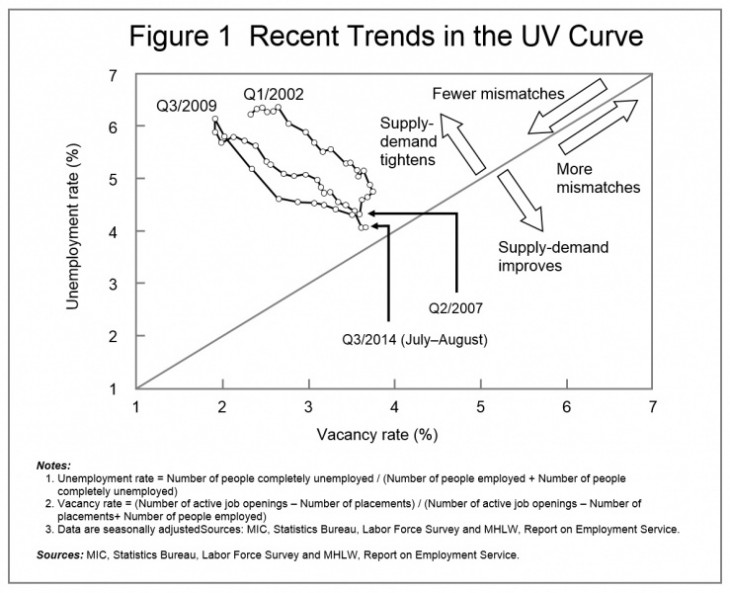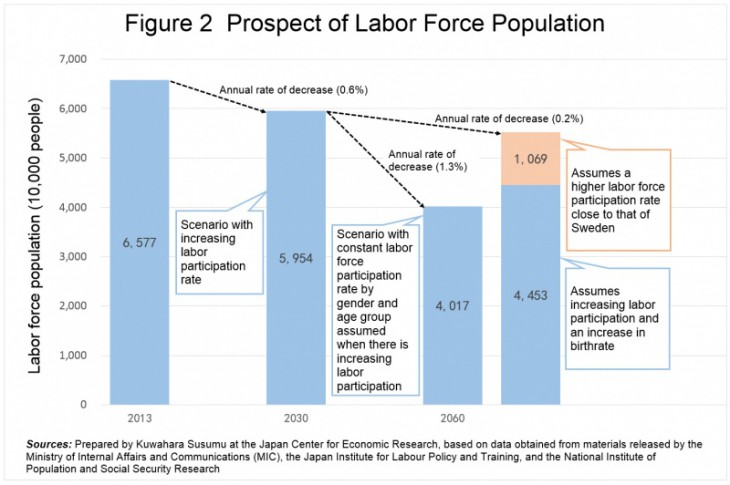Tightening Job Market Begins to Drag Down the Economy — Challenges Confronting the Second Stage of Abenomics

Komine Takao, Professor, Hosei Graduate School of Regional Policy Design
Since the spring of 2014, a labor shortage in Japan has emerged as a sudden challenge to its economy. Until just before this shortage became apparent, our normal discussions on the economy primarily focused on possible countermeasures that could be taken to address unemployment issues, which were for the most part intended to provide for employment opportunities in response to such questions as “How do we put an end to the rising unemployment rate?” or “How do we improve the employment of young adults?” and “How do we ensure employment for the elderly by the time they start receiving pension?” But after the spring of 2014, Japan was suddenly confronted with a labor shortage, which must have been a huge surprise to the general public at the time.
I believe that the package of economic measures called Abenomics, which was launched in November 2012, can be divided into two stages. The first stage was the period lasting up until March 2014, and the second stage began the following month of April. During the first stage of Abenomics, the nation’s economy underwent a successful recovery that went beyond the general consensus forecast of many economists. But in the second stage of Abenomics, many of the latent causes of the labor shortage during the first stage have started becoming more apparent. Given this ongoing recent development, I believe that the labor shortage issue represents one of the major challenges confronting Abenomics in its second stage.
There are a few points I would like to address in this article. The first concerns the causes of this sudden labor shortage in Japan, and whether it is a temporary cyclical phenomenon or a long-term structural problem. The second concerns the implications of this shortage. What would it mean for Japan in the second stage of Abenomics to adapt its policy towards an economy characterized by a labor shortage?
A Sudden Recovery in the Employment Situation Parallels Rising Wages
First, I will use related statistics to provide an overview of the recent labor shortage situation. Backed by economic expansion that has continued since November 2012, Japan has seen a rapid recovery in its employment situation. The jobs-to-applicants ratio in Japan rose from 0.82 in November 2012 to 1.10 in June 2014 (the corresponding ratio for February 2015 was 1.15), which was the highest record in twenty-two years since June 1992.
At the same time, the unemployment rate fell from 4.1% in November 2012 to 3.5% in May 2014. It temporarily rose slightly in the following months, but dropped back down again to 3.5% in August 2014.
Given the tightening supply-demand situation on the labor market, wages also started to rise. According to the Monthly Labour Survey released by the Ministry of Health, Labour and Welfare, total cash earnings (in nominal terms) in 2013 were more or less in line with the previous year’s level, but they showed a 0.8% increase in 2014.
In contrast, wages in real terms (adjusted for consumer price increases) showed a 0.5% decline in 2013 on a year-on-year basis, which was followed by a 2.5% decline in 2014.
This phenomenon of “higher wages in nominal terms but lower wages in real terms” symbolizes the challenge confronting Abenomics in its second stage. I will discuss this phenomenon in greater detail later on in this article.
During the first stage period, the economy experienced a significant recovery and Abenomics produced real results. Corporate profits recovered substantially, and momentum was restored to the growth of the country’s economy. The rate of change in the consumer price index, which had long been hovering around the minus range, seems to be moving away from this range in a stable manner. In my opinion, the economic turnaround in the first stage of Abenomics was supported by the depreciation of the yen, strong stock prices, higher public investment, and a spike in demand ahead of the sales tax hike.
In reaction to the favorable performance of Abenomics, the mood surrounding the economy changed. There was rapid progress in the depreciation of the yen and rise in stock prices. The weaker yen helped to increase profits in the manufacturing industry and push up consumer prices as a result of the rise in the price of imported products. The rising stock prices created an assets effect that increased household economic consumption. The substantial increase of public investment pushed up the GDP. Furthermore, a last-minute rise in demand took place on a large scale in the 2013 fiscal year in the face of the upcoming sales tax rate hike in April 2014. This eventually led to higher household consumption expenditures and active housing investment.
However, when Abenomics entered the second stage in April 2014, the alarm bells started to ring about the successes of the first round of Abenomics. The depreciation of the yen and rise in stock prices lost their initial momentum, and instead began to be viewed negatively by the market. Public investment, which has already reached its limit, is no longer capable of driving economic growth further because the amount of investment for the 2014 fiscal year is likely to fall short of the previous year’s level. In addition, a substantial decline in the GDP was recorded for the April–June period of 2014 (down 7.1% year-on-year on an annualized basis) as a result of the reactionary plunge in demand following the spending spree ahead of the sales tax hike. In fact, some economists argue that the country’s economy has already entered a recessionary phase. It appears that this view is gradually gathering strength today.
So what is next? Given the current circumstances in which there are “higher wages in nominal terms but lower wages in real terms,” I believe wage hikes will be the key to Abenomics’ success going forward. Assuming that Japan remains on the course of this current economic turnaround, an improvement in the supply-demand situation on the labor market as well as wage hikes will be essential to sustain this trend. I believe that higher wages with fewer risks of unemployment would eliminate people’s concerns over the future prospects of household economic consumption. This in turn would encourage consumer spending and eventually help to support the nation’s economy on the whole.
Meanwhile, lower wages in real terms remain a risk factor. The accelerated decline in real wages on a year-on-year basis in the second stage of Abenomics was attributable to higher consumer prices caused by the sales tax hike. An increase of three percentage points in the sales tax rate is usually large enough to push up the prices of goods and services in general and eventually lead to higher consumer prices. (A three-percentage point increase in sales tax is generally believed to push up consumer prices by two percentage points.) Naturally, a sales tax hike does not guarantee an increase in wages, meaning that wages in real terms would typically decrease by two percentage points as a result of the sales tax hike. This is the reason for the lower wages in real terms experienced in the second stage of Abenomics. Lower wages in real terms will no doubt discourage consumer spending and eventually have a negative impact on the nation’s economy.
I believe we will continue to see a tug-of-war between different forces, namely the rising nominal wages driven by the labor shortage and the falling real wages caused by the sales tax hike. Whichever exercises the greater influence will have a major impact on the economy in the second stage of Abenomics.
Falling Labor Force Population and Emerging Factors to Inhibit Labor Supply in the Midst of a “Population Onus”
The current labor shortage is a byproduct of the recent improvement in the supply-demand situation on the labor market. At this point in time, the improvement is starting to be perceived more as a phenomenon causing a general lack of available labor resources that will restrict the economic growth, even though previously everyone was pleased with the lower unemployment rate.
First, the jobs-to-applicants ratio in July 2014 was 1.10 as mentioned previously. This ratio is obtained by dividing the number of active job openings (numerator) by the number of active applicants (denominator). Thus, the corresponding ratio of over 1 for July 2014 indicated that the number of jobs offered by companies was higher than that of job seekers. In other words, this suggests that the situation has moved beyond the labor market equilibrium, where neither a labor excess nor a labor deficit is observed. Instead, what has occurred is a labor shortage.
This view is also generally shared among business enterprises in Japan. According to the Bank of Japan’s monthly “Tankan” (Short-term Economic Survey of Enterprises in Japan) released after March 2014, businesses of all sizes that faced a labor shortage outnumbered those with a surplus labor in their respective employment environments. The Tankan survey for June 2014 indicated that the manpower shortage was more severe among small and medium-sized businesses, and had reached the most serious level for these businesses since the economic bubble burst.
Next, I will discuss the decline in unemployment rate in greater detail. In general, there are two categories of unemployment: deficient demand unemployment and structural unemployment (due to a mismatch between the labor supply and demand). An analytical method, called “Unemployment-Vacancy (UV) analysis,” has been developed to break the unemployment rate down into the two different categories mentioned above. Figure 1 shows the recent trends in the “UV curve” as illustrated by Professor Murata Keiko of Tokyo Metropolitan University.
The UV curve is a graphical representation of the relationship between the unemployment rate on the vertical axis and the vacancy rate on the horizontal axis. The intersection between the UV curve and a 45-degree line indicates where supply and demand coincide. The unemployment rate at this point is the rate at which no demand deficiency exists. Instead, the unemployment rate at this point is caused by a mismatch between the labor supply and demand because the labor market is assumed to be in equilibrium there. In other words, the intersection between the UV curve and the 45-degree line is considered to be the equilibrium of unemployment rate, which is a state where the aggregate supply and demand in the labor market are equal. The unemployment rate at this intersection is considered to be a proxy indicator of unemployment caused by a mismatch of skills.
In Figure 1, the UV curve starts with the first quarter of 2002 and later exhibits a downward shift to the right (indicating the expansionary periods). After that, the curve moves upward to the left towards 2009 (indicating the recessionary periods), and then rapidly slopes downward to the right toward the third quarter of 2014. More recently, the curve has hovered around the 45-degree line. This suggests that the latest unemployment rate points to a state of unemployment in which the aggregate supply and demand in the labor market is almost equal, and that recent unemployment is largely attributable to a mismatch between the labor supply and demand.
This analysis presents an extremely important point because it suggests that a mere recovery in the economy does not lead directly to a lower unemployment rate going forward. Furthermore, it suggests that the government needs to focus on structural measures to tackle labor mismatches (such as greater emphasis on public job placement services, more job training opportunities, and smooth labor mobility) in order to improve the employment situation in the country.
The important point here is that the declining trend in the country’s labor force is likely to accelerate further heading into the future due to the ongoing population onus. Japan’s working-age population hit its peak in 1995 at 87.3 million, and has consistently been on the decline ever since. The recorded working-age population in 2014 (as of October 1) was 77.9 million, and since 1995 its ratio to the total population has fallen from 69.5% to 61.3%. As a result, the labor force population also fell from its peak of 67.93 million in 1998 to 65.87 million in 2014.
The real test is yet to come. The working-age population of Japan is projected to decline further to 67.73 million in 2030 and 44.18 million in 2060 according to projections (medium-variant fertility and mortality assumptions) by the National Institute of Population and Social Security Research. As the population onus intensifies in the upcoming decades, labor force population will no doubt experience a substantial decline, despite efforts to raise the employment rate of the elderly and women to a certain extent. It must be noted, however, that elevating the employment rate of the elderly and women is no easy task because the labor force participation rate will have to be projected by gender and age group in order to make projections for the labor force population in the future.
Let us take a look at the estimation made by Kuwahara Susumu, the principal economist at the Japan Center for Economic Research. Kuwahara estimated the labor force participation rate in 2030 and 2060 based on the data for 2013 (Figure 2). The estimation shows that despite a certain increase in the labor participation rate and the effects of the government policies, the labor force population is projected to fall from 65.77 million in 2013 to 59.54 million in 2030, and then down to 40.17 million in 2060. The annual rate of decrease for the period from 2013 to 2030 will be 0.6% on average, and then it is expected to accelerate to 1.3% during the period from 2030 to 2060. Last year, the Committee for Japan’s Future, a task force organized by the Council on Economic and Fiscal Policy, released an interim report that listed a reference figure of 55.22 million for the estimated labor force population in 2060 (see the right-end bar in Figure 2). In this case, the annual rate of decrease in the labor force population for the period from 2030 to 2060 will be limited to something like 0.2%. However, it is important to note that the government panel’s estimation was based on extremely optimistic assumptions, such as the birthrate recovering to 2.07 by 2030, the labor force participation rate of Japanese women rising to the level of Sweden by 2030, and the labor force participation rate of the elderly over 60 remaining the same for five more years because of the recent improvement in their physical abilities.
Previously Japan had seen the structural lowering of the ceiling of its labor force. That being the case, the rapid expansion in labor demand driven by the economic recovery instantaneously absorbed the lowering of the supply, which has eventually resulted in labor shortages. This explains the tightening job market that has emerged all of sudden.
I believe it is reasonable to expect the labor market in Japan to become increasingly tight going forward, unless a recession causes the demand for labor to become extraordinarily low. This labor shortage trend is our future.
Change in the Economy from Demand Shortage to a Supply Shortage
Assuming that the labor shortage will continue for years to come, it will serve as a factor driving major change in the second stage of Abenomics. In that sense, it is important to monitor the supply-demand gap. The supply-demand gap is an index that indicates the strength of actual demand in relation to the potential production capability of Japan’s economy.
According to the inductive statistics released by the Cabinet Office, the supply-demand gap for the January–March period of 2014 narrowed to minus 0.3% (excess supply). Given the significantly negative economic growth for the April–June period, the gap widened to minus 2.2%. However, if solid growth continues, the supply-demand gap will move back into the positive region (short supply).
These statistics suggest that Japan’s entire economy has started undergoing a sea change, shifting from a situation characterized by a demand shortage to that of a supply shortage. In the wake of this significant change, we need to reconsider the basic direction of economic policies.
In other words, economic policies have focused on boosting demand because of the demand shortage that existed in the country. The goals of both the drastic monetary easing as part of the first arrow of Abenomics and the increase in public spending (the second arrow) were to stimulate, meaning that these arrows were essentially economic policies designed for an era characterized by demand shortage. Going forward, however, it is important to enhance the supply capacity. That is what the growth strategy, the third arrow of Abenomics, seeks to accomplish. If the demand grows further without enhancing the labor supply capacity, there will be no improvement in the unemployment rate and consumer prices will continue to rise. For example, in an era of demand shortage, an increase in public spending led to automatic GDP growth. However, in an age with a supply shortage, public spending may be delayed because of a lack of construction workers, which will drag down the country’s economic growth.
The Need for Labor Mobility and a “Membership-based” Employment System
As discussed previously, I believe that it is imperative for the government to address the labor shortage problem from long-term perspectives that aim to enhance supply capacity. This will no doubt be a major part of the growth strategy in the second stage of Abenomics. The next steps that must be considered are the effective options available to Japan to achieve this goal. I understand that the government has been focusing on measures to develop the unutilized potential of women. But what is more important as well as more challenging is an initiative to encourage labor mobility.
Greater labor mobility will encourage a more flexible movement of labor. It will help move people from declining industries to growing industries, from declining companies to growing companies, and from low productivity divisions to high productivity divisions. This type of movement will stabilize the employment situation, and we will see production improve along with a higher income on the part of the workers. As mentioned earlier, the existing unemployment situation is not attributable to a shortage of employment opportunities, but instead largely reflects labor mismatches between supply and demand. Greater labor mobility will make it easier to eliminate these mismatches.
It is important to note, however, that the government seems to avoid using the term “labor mobility” in its economic growth strategy. To many people, the term “labor mobility” tends to conjure up images of something that is unstable or fragile. This kind of general perception regarding the word may be the reason behind the government’s reluctance to use the term “labor mobility.”
On the other hand, the concept of encouraging labor mobility is based on an idea that is commonly accepted among many economists. Achieving the optimal allocation of resources by rational individual behavior through market mechanisms is one of the basic functions of economics. When it comes to employment, the number of job offerings tends to increase in conjunction with rising wages when there is a labor shortage. In contrast, people may lose their jobs or suffer a pay cut in areas where there is an excess of labor. Given the backdrop of this situation, an economic agent with rational behavior would encourage people to work in the areas with labor shortages (growing areas) and leave the areas with excess labor (declining areas). In this fashion, the optimal allocation of labor will be achieved by the smooth adjustment of labor between supply and demand.
In order to achieve the optimal allocation of labor, it will become necessary to make it as easy as possible for people in the labor force to move from a declining area to a growing area without having to stay in one area all the time. That is what labor mobility is all about.
My discussion so far may leave the impression that I am only focused on the economic efficiencies that may be achieved, but achieving greater labor mobility will be good news to workers. With the optimal allocation of labor in place, workers will receive the maximum wages matched to their individual abilities. With a rigid employment model dominating the labor market, a Japanese worker typically has no choice but to stay employed at the same company for life, even though he or she just happened to be hired by that company. It would be ideal if the company actually fits the worker’s preference, but the truth is that there are probably many people out there who have thought “this is not what I signed up for. I would have been better off working for another company.” Nevertheless, people choose to stay employed at the same company out of fear of losing their jobs. Basically, they suppress their frustration in exchange for obtaining job security.
Ultimately, the idea of enhancing labor mobility represents an orthodox economic policy rooted in the fundamental principles of economics. In order to encourage labor mobility, I believe that we would be better off fundamentally changing Japan’s traditional working style (or employment practices). Some options have already been suggested, such as the creation of a semi-regular worker status and a full-time worker status under a geographically confined employment program for those who fall between regular and non-regular worker status, the relaxation of restrictions on employment termination with the aim of encouraging labor mobility for regular employees, and the removal of age-based retirement as well as the retirement allowance system.
The aforementioned changes in the working style can be referred to as a change from “membership-based employment” to “job-based employment.” The concepts of membership-based and job-based employment were developed by Hamaguchi Keiichiro of the Japan Institute for Labour Policy and Training. In my understanding of these concepts, the job-based employee status will allow for worker career development based on individual work achievements and expertise, while the membership-based work only allows for career development specific to the organization (business company, government office, etc.) to which the worker belongs. Needless to say, Japan’s traditional employment style is largely based on the membership-based employment model.
In a membership-based system, regular employees are typically provided with predominantly company-specific career development opportunities that inhibit labor mobility. However, under the job-based system it may become easier for people in the labor force to migrate to growing industries or companies. Moreover, the membership-based employment model usually makes it disadvantageous to work from the outset for women with a high likelihood of leaving the workforce because of marriage and childbearing, and tends to force them to settle for non-regular, low-paying jobs when they want to work again after raising kids. On the other hand, the availability of a job-based employee status would help to eliminate the disadvantages for female workers, making it easy for women who wish to find a job that is well suited to their abilities after raising their children.
In conclusion, I would like to emphasize that the government should strive to achieve increased fluidity in the labor force with a solid commitment to making a shift towards a job-based model of employment in the long run. I believe this should be the basic course of action to be adopted by the Japanese government in its employment system reformation initiatives.
Translated from “Tokushu – Jinko gensho ga tsukitsukeru Koyo gekihen / Abenomikusu dai-ni maku ga chokumen suru kadai: Rodoryokubusoku ga keizai wo seiyaku shihajimeteiru (Challenges Confronting the Second Stage of Abenomics — Tightening Job Market Begins to Drag Down the Economy),” Chuokoron, December 2014, pp. 36–42. (Courtesy of Chuo Koron Shinsha) [December 2014]






